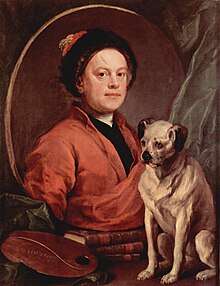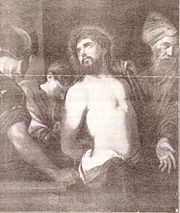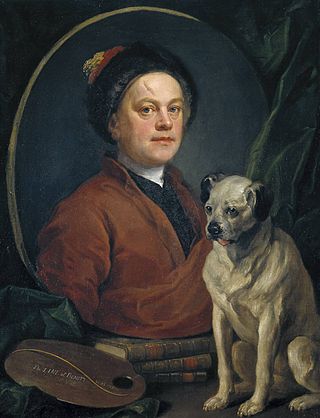
William Hogarth was an English painter, engraver, pictorial satirist, social critic, editorial cartoonist and occasional writer on art. His work ranges from realistic portraiture to comic strip-like series of pictures called "modern moral subjects", and he is perhaps best known for his series A Harlot's Progress, A Rake's Progress and Marriage A-la-Mode. Familiarity with his work is so widespread that satirical political illustrations in this style are often referred to as "Hogarthian".

Thomas Bewick was an English wood-engraver and natural history author. Early in his career he took on all kinds of work such as engraving cutlery, making the wood blocks for advertisements, and illustrating children's books. He gradually turned to illustrating, writing and publishing his own books, gaining an adult audience for the fine illustrations in A History of Quadrupeds.

De Humani Corporis Fabrica Libri Septem is a set of books on human anatomy written by Andreas Vesalius (1514–1564) and published in 1543. It was a major advance in the history of anatomy over the long-dominant work of Galen, and presented itself as such.
A Rake's Progress is a series of eight paintings by 18th-century English artist William Hogarth. The canvases were produced in 1732–1734, then engraved in 1734 and published in print form in 1735. The series shows the decline and fall of Tom Rakewell, the spendthrift son and heir of a rich merchant, who comes to London, wastes all his money on luxurious living, prostitution and gambling, and as a consequence is imprisoned in the Fleet Prison and ultimately Bethlem Hospital (Bedlam). The original paintings are in the collection of Sir John Soane's Museum in London, where they are normally on display for a short period each day.
A Harlot's Progress is a series of six paintings and engravings (1732) by the English artist William Hogarth. The series shows the story of a young woman, M. Hackabout, who arrives in London from the country and becomes a prostitute. The series was developed from the third image. After painting a prostitute in her boudoir in a garret on Drury Lane, Hogarth struck upon the idea of creating scenes from her earlier and later life. The title and allegory are reminiscent of John Bunyan's Pilgrim's Progress.
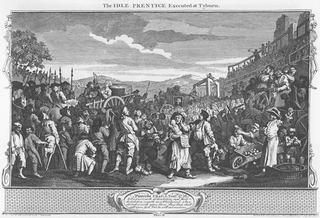
Industry and Idleness is the title of a series of 12 plot-linked engravings created by the English artist William Hogarth in 1747, intending to illustrate to working children the possible rewards of hard work and diligent application and the sure disasters attending a lack of both. Unlike his earlier works, such as A Harlot's Progress (1731) and Marriage à-la-mode (1743), which were painted first and subsequently converted to engravings, Industry and Idleness was created solely as a set of engravings. Each of the prints was sold for one shilling each so 12 shillings for the entire set, which is equivalent to £120 in 2023. It may be assumed that these prints were aimed for a wider and less wealthy market than his earlier works. The originals currently reside at the British Museum.

Four Times of the Day is a series of four oil paintings by English artist William Hogarth. They were completed in 1736 and in 1738 were reproduced and published as a series of four engravings. They are humorous depictions of life in the streets of London, the vagaries of fashion, and the interactions between the rich and poor. Unlike many of Hogarth's other series, such as A Harlot's Progress, A Rake's Progress, Industry and Idleness, and The Four Stages of Cruelty, it does not depict the story of an individual, but instead focuses on the society of the city in a humorous manner. Hogarth does not offer a judgment on whether the rich or poor are more deserving of the viewer's sympathies. In each scene, while the upper and middle classes tend to provide the focus, there are fewer moral comparisons than seen in some of his other works. Their dimensions are about 74 cm (29 in) by 61 cm (24 in) each.

James Field was a sailor and boxer in England in the 18th century who was hanged for robbery.

The Bench is the title of both a 1758 oil-on-canvas painting by the English artist William Hogarth, and a print issued by him in the same year. Unlike many of Hogarth's engravings produced from painted originals, the print differs considerably from the painting. It was intended as a demonstration of the differences between character painting, caricature and outré—developing on the theme he had begun to address in Characters and Caricaturas —but Hogarth was unhappy with the result as it showed only "characters", and he continued to work on the piece until his death.
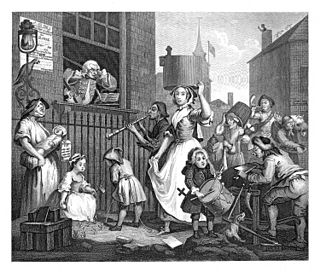
The Enraged Musician is a 1741 etching and engraving by English artist William Hogarth which depicts a comic scene of a violinist driven to distraction by the cacophony outside his window. It was issued as companion piece to the third state of his print of The Distrest Poet.

The Distrest Poet is an oil painting produced sometime around 1736 by the British artist William Hogarth. Reproduced as an etching and engraving, it was published in 1741 from a third state plate produced in 1740. The scene was probably inspired by Alexander Pope's satirical poem The Dunciad. It depicts a scene in a small, dingy attic room where a poet sits at his desk in the dormer and, scratching his head, stares at the papers on the desk before him, evidently looking for inspiration to complete the poem he is writing. Near him sits his wife darning clothes, surprised by the entrance of a milkmaid, who impatiently demands payment of debts.

Beer Street and Gin Lane are two prints issued in 1751 by English artist William Hogarth in support of what would become the Gin Act. Designed to be viewed alongside each other, they depict the evils of the consumption of gin as a contrast to the merits of drinking beer. At almost the same time and on the same subject, Hogarth's friend Henry Fielding published An Inquiry into the Late Increase in Robbers. Issued together with The Four Stages of Cruelty, the prints continued a movement started in Industry and Idleness, away from depicting the laughable foibles of fashionable society and towards a more cutting satire on the problems of poverty and crime.

Columbus Breaking the Egg is a 1752 engraving by English artist William Hogarth. Issued as the subscription ticket for his treatise on art, The Analysis of Beauty, it depicts an apocryphal tale concerning Christopher Columbus's response to detractors of his discovery of the New World. Hogarth uses the story as a parallel to what he considered his own discoveries in art.

The March of the Guards to Finchley, also known as The March to Finchley or The March of the Guards, is a 1750 oil-on-canvas painting by English artist William Hogarth, owned by and on display at the Foundling Museum. Hogarth was well known for his satirical works, and The March of the Guards to Finchley has been said to have given full scope to this sense of satire; it was described by Hogarth himself as "steeped in humour".

Emblematical Print on the South Sea Scheme is an early print by William Hogarth, created in 1721 and widely published from 1724. It caricatures the financial speculation, corruption and credulity that caused the South Sea Bubble in England in 1720–21. The print is often considered the first editorial cartoon or as a precursor of the form.
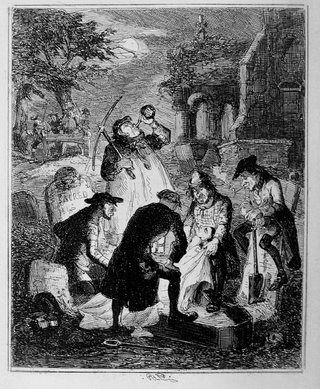
Resurrectionists were body snatchers who were commonly employed by anatomists in the United Kingdom during the 18th and 19th centuries to exhume the bodies of the recently dead. Between 1506 and 1752 only a very few cadavers were available each year for anatomical research. The supply was increased when, in an attempt to intensify the deterrent effect of the death penalty, Parliament passed the Murder Act 1752. By allowing judges to substitute the public display of executed criminals with dissection, the new law significantly increased the number of bodies anatomists could legally access. This proved insufficient to meet the needs of the hospitals and teaching centres that opened during the 18th century. Corpses and their component parts became a commodity, but although the practice of disinterment was hated by the general public, bodies were not legally anyone's property. The resurrectionists therefore operated in a legal grey area.

A History of British Birds is a natural history book by Thomas Bewick, published in two volumes. Volume 1, Land Birds, appeared in 1797. Volume 2, Water Birds, appeared in 1804. A supplement was published in 1821. The text in Land Birds was written by Ralph Beilby, while Bewick took over the text for the second volume. The book is admired mainly for the beauty and clarity of Bewick's wood-engravings, which are widely considered his finest work, and among the finest in that medium.

Trump was a pug owned by English painter William Hogarth. He included the dog in several works, including his 1745 self-portrait Painter and his Pug, held by the Tate Gallery. In the words of the Tate's display caption, "Hogarth's pug dog, Trump, serves as an emblem of the artist's own pugnacious character."

Jane Hogarth was a British printseller and businesswoman who preserved the rights to the artwork of her husband, William Hogarth, following his death. She successfully continued to produce and sell his work for many years.
